| Please note that these pages are from our old (pre-2010) website; the presentation of these pages may now appear outdated and may not always comply with current accessibility guidelines. |
| Please note that these pages are from our old (pre-2010) website; the presentation of these pages may now appear outdated and may not always comply with current accessibility guidelines. |
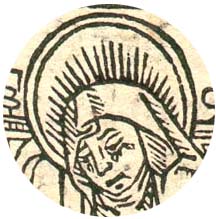
| The Book of the Month for July is one of ten books printed by William Caxton now in Glasgow University Library. William Caxton (1422?-1491) is famous for introducing the art of printing to England. Johann Gutenberg invented the printing press in Germany in around 1450 and this new technique for the mass manufacture of texts spread slowly around Europe. Caxton began printing in about 1471 and produced some 100 works over a twenty year period. |
|
Prohemium (folio a4r) |
Caxton was born in Kent. In 1438, he was apprenticed to
Robert Large, a leading textile merchant. After Large's death in 1441,
Caxton moved to Bruges, the foremost centre for trade between the English
and the Flemish, and built up a thriving textile business. Prominent as a
merchant, by 1463 he was acting governor of the Merchant Adventurers in the
Low Countries and was also engaged in various diplomatic negotiations on
behalf of Edward IV. Caxton seems to have lost his post after Edward's exile
in 1470-71. He moved to Cologne where he is said to have spent a year
learning how to print. Caxton first set up a printing press in Bruges. Here he produced his first work in around 1474, his own translation of The Recuyell of the Historyes of Troye made under the patronage of Margaret of York, Duchess of Burgundy. In 1476 he returned to England and opened a printing shop at Westminster at the sign of the Red Pale. The Mirror of the Blessed Life of Jesus Christ is a fifteenth century English translation of the Latin Meditationes Vitae Christi, a work usually described as being pseudo-Bonaventuran. A devotional life of Our Lord, intended to be used for meditation, this work was immensely popular all over Europe and was rendered into the vernacular of most continental countries. Divided into some 63 chapters, this version covers the events of the life of Christ in imaginative detail; the sections devoted to the childhood and the passion are especially powerful.
|
| This is a copy of the second edition, printed c. 1490, a page for page
reprint of the first edition which was originally published in 1486: only
one copy of the first edition is known to survive, now in Cambridge
University Library. The editions vary considerably in the spellings, but the
most obvious change is in the headlines which are found throughout the
greater part of the book, and run as Ca. in the first edition and
Capitulum in the second. Caxton's device should be present on the verso
of the last leaf of the second edition, but unfortunately in our copy this
final leaf is missing.
Our copy also lacks the first three leaves, including the 'incipit' or opening of the text. In books of this age it is quite common to find the first and last pages now missing, these being the most vulnerable to wear and tear over time. But our copy is also imperfect in lacking several of its internal leaves of text. Its pages are generally stained and sometimes torn at the edges, warranting its description in de Ricci's Census of Caxtons as being 'much dilapidated'.
|
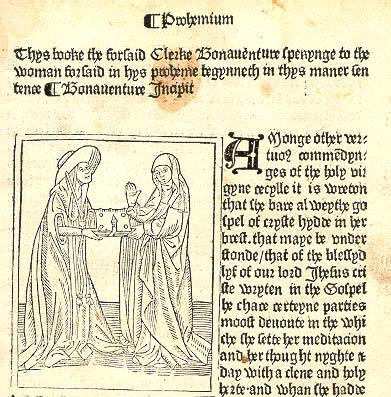 Prohemium (folio a6r) |
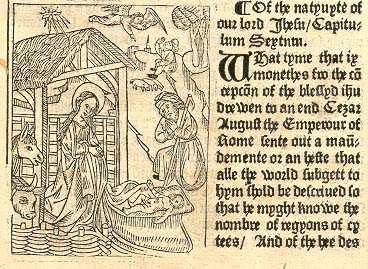
Of the natyuyte (folio c6v) |
The book is printed in Caxton's 'Type 5'. During his career as a printer, Caxton used eight separate founts. This typeface was cut by Johann Veldener, a printer and typefounder, and is designed like the characters of the Bible and Psalter of the early Mainz printers; more than any other of Caxton's types, its style approaches that of 'black letter' or gothic print. Caxton used it for church Latin texts as well as for English books. Caxton's technical skill as a printer has often been questioned and his typefaces criticised. However, the Burgundian black letter style of the fonts was rooted in his long residence in the Netherlands and they were admired during his time; their use and popularity did not wane for more than a century. |
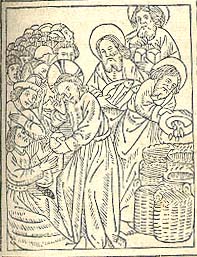
Of the fedynge ... (folio h6r) |
Twenty-seven woodcuts illustrate the text. According to Hodnett, these 'traditional designs of the life and Passion of Jesus fit neatly into the space of the blocks, and the even distribution of line work makes them seem to belong on the type page'. Caxton imported them from the continent for the first edition of the work. Stylish and elegant, they are probably northern French in origin. As well as being re-used in the second edition, the blocks were inherited by Wynkyn de Worde, Caxton's successor, and used in four further reprints of the Mirror, although they become increasingly cracked. |
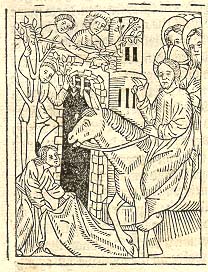 how Jhesus came to iherusalem (folio l7v) |
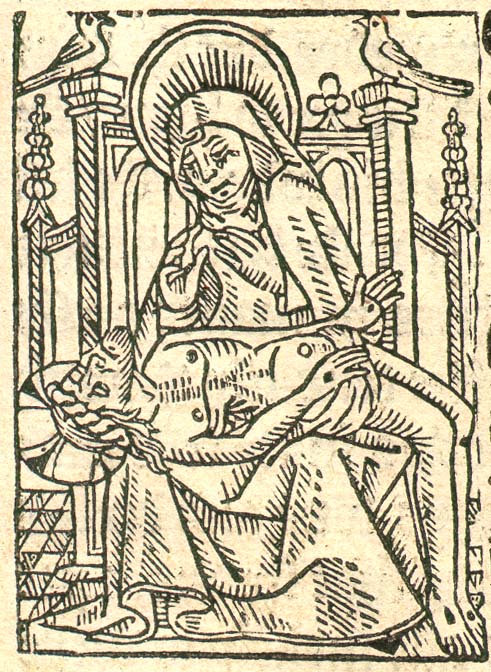 of the burieng of oure lord Jhesu (folio p1r, enlarged) |
It is thought that Caxton's acquisition of this set of
religious blocks influenced his choice of books to print: these
woodcuts could be re-used in several different works and naturally
Caxton wished to make use of them. Certainly, it seems likely that the
existence of the series lead him to publish a second edition once the
first had sold out.
Also used in the Mirror are a few smaller cuts, including the illustration of Mary weeping over the body of Jesus shown here both in its actual size and as significantly enlarged. These little blocks were probably first used in a Horae ad Usum Sarum, of which no complete copy is now known. They are Flemish in style. |
| Nicholas Love, prior of the Carthusian House of Mount Grace in Ingleby in Yorkshire, was responsible for this translation of the Mirror. It was completed by 1410 when it was licensed for reading by Archbishop Arundell. Nothing is known about Nicholas Love beyond the statement that he was the translator of the work, as found in many extant manuscripts. However, Love frequently censures the Lollards throughout the text, and refuting Lollard doctrine seems to have been his special polemical purpose. The translation became one of the most influential Middle English prose devotional works, and was important as a fundamental source both for contemporary religious drama and the visual arts. Containing some of the finest English prose of any time, its popularity is evident in the large number of manuscripts which survive. |
|
colophon |
Other items of interestA Fifteenth Century manuscript version of The Myrrour of the Blessid Lif of Ihesu-Crist, translated by Nicholas Love: MS Hunter 77 (T.3.15) Other editions by Caxton: Cordyale, or Four last thinges 24 March 1479: Hunterian Bv. 2. 21; The Chronicles of England 10 June 1480: Hunterian Bv. 2. 31; Godefroy of Boloyne, or the siege and conqueste of Jherusaslem, or Eracles 20 November 1481: Hunterian Bv. 2. 29; Polycronycon after 2 July 1482: Hunterian Bv. 2. 9; The book callid Cathon after 23 December 1483: Hunterian Bv. 2. 16; The lyf of our Lady 1484: Hunterian Bv. 2. 20; The legends named in latyn legenda aurea 1487?: Hunterian Bg. 1. 1; The Myrrour of the worlde 1490: Hunterian Bv. 2. 30; The bok yf Eneydos after 22 June 1490: Hunterian Bv. 2. 10 See also the online Printing in England exhibition
|
|
Return to main Special Collections Exhibition Page Julie Coleman July 2000
|